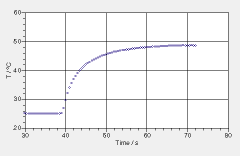A thermometer is in air at room temperature. It is suddenly put into hot water. After the temperature reading has stabilized, it is taken out of the water, dried, and left lying in air at room temperature (data of process is shown in the diagrams). Data of this and a second experiment is found in Thermometer_Response.xls.
a. Determine the time constant for the temperature sensor in water by hand (without additional aids except for a calculator, and without transforming the graph). How could you do this most easily? What is the time constant? b. Transform the temperature data for the equilibration in air (after 120 s) in such a way that the transformed temperature appears as a linear function. Use this diagram to determine the time constant of the thermometer in air. c. Assume the heat transfer coefficient from the thermometer (steel) to air to be about 14 W/(K·m^2). How large is the heat transfer coefficient from water to the thermometer? d. The thermometer is taken from the kitchen at 20°C and placed into an oven at 180°C for 1.5 minutes. Then it is placed in the kitchen again. Sketch the expected behavior of the temperature reading (T(t); use numerical values where necessary and possible). e. Create a simple system dynamics model of the thermometer and repeat problem d using this numerical model. f. The thermometer is used in air whose temperature cycles according to the function | | 
Click to obtain pdf for printing

Click to obtain pdf for printing
T(t) = a·sin(bt) + c, where a = 3.0 K, b = 2pi/20 1/s, c = 293 K. Use the SD model to determine the response of the thermometer. Is the temperature probe a useful device for this task? If not, how yould you make it a better thermometer? |

